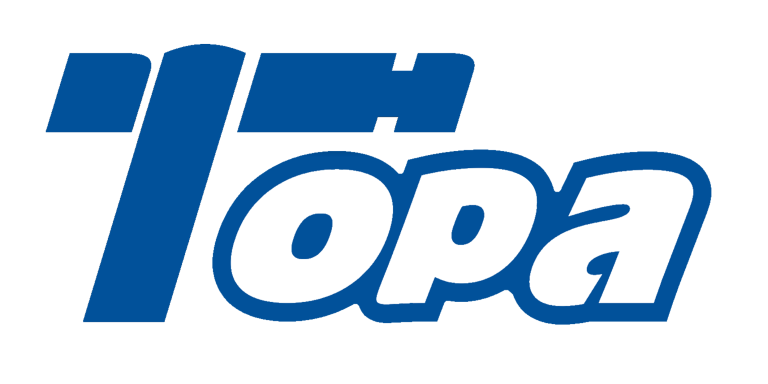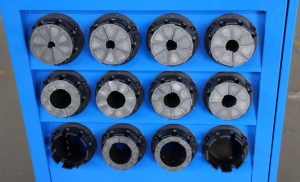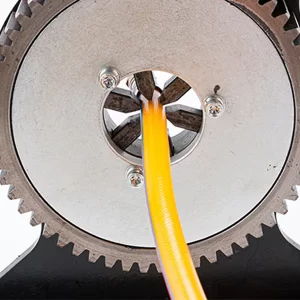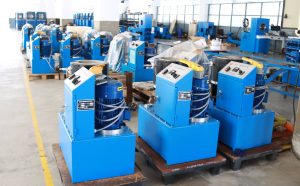Hydraulic hose crimpers are essential tools for creating secure and reliable hydraulic hose assemblies. However, many operators make common mistakes that compromise safety, efficiency, and the integrity of the hose assemblies. This article titled “What Are the Common Mistakes When Using a Hydraulic Hose Crimper?” explores these pitfalls in detail. Understanding these mistakes will help businesses improve operational safety, reduce waste, and extend equipment lifespan. The article covers errors related to equipment selection, improper operation, maintenance neglect, and more. Whether you are new to using hydraulic hose crimpers or an experienced operator, this guide will enhance your knowledge and help you avoid costly errors.
1 What mistakes are made when selecting the wrong hydraulic hose crimper?
Choosing the wrong hydraulic hose crimper is a common error that leads to poor results and wasted resources. Many users fail to consider the hose diameter range or the type of fittings when purchasing a crimper. For instance, using a crimper designed for small-diameter hoses on larger hoses will not provide the required crimping force, causing leaks or failures. Conversely, an oversized crimper might be inefficient and costly for small-scale jobs. What’s the real story? Selecting a crimper without evaluating operational needs, hose types, and production volume sets the stage for ongoing problems and increased downtime. Additionally, some businesses overlook power source compatibility, which can affect machine functionality. Examples include shops buying electric crimpers where only pneumatic power is available, leading to unusable equipment.
Table 1: Common Errors in Crimper Selection
| Mistake | Consequence | Real-world Example |
|---|---|---|
| Incorrect hose size | Leaks, weak crimps | Using small crimper for 2” hoses |
| Ignoring fitting types | Poor fit, operational issues | Standard crimper on specialty fittings |
| Mismatched power source | Machine unusable | Electric crimper in field with no power |
2 What operational errors affect hydraulic hose crimping quality?
Operational mistakes during crimping directly impact hose performance. One frequent error is improper die placement, where the hose is not aligned correctly within the die, leading to uneven crimps. Another is applying insufficient or excessive crimping force; too little force fails to secure the fitting, while too much damages the hose or fitting. Also, neglecting to clean hoses or fittings before crimping introduces contaminants, risking leaks and premature failure. Case studies from manufacturing facilities showed that operator training reduces crimp defects by over 35%. But here’s the kicker: even experienced operators can develop bad habits without regular retraining and supervision, making continuous education critical.
Table 2: Common Operational Mistakes and Effects
| Operational Error | Impact | Prevention |
|---|---|---|
| Misaligned die placement | Uneven crimps, leaks | Proper training, visual checks |
| Incorrect crimp force | Damage or loose fittings | Calibrated equipment, force checks |
| Contaminated components | Premature failure | Clean hoses and fittings |
3 How does neglecting maintenance lead to hydraulic hose crimper failures?
Maintenance neglect is a silent killer of hydraulic hose crimpers. Crimpers require regular lubrication, inspection of hydraulic systems, and timely replacement of worn dies. Failure to maintain leads to decreased crimping accuracy, equipment breakdowns, and costly repairs. For example, worn dies produce inconsistent crimps, causing safety risks. Maintenance logs from hydraulic shops reveal that routine maintenance cuts downtime by 40%. Ready for the good part? Establishing a preventative maintenance schedule, including daily checks and annual overhauls, significantly prolongs crimper life and ensures consistent performance.
Table 3: Maintenance Neglect Effects and Solutions
| Neglect Area | Consequence | Recommended Maintenance |
|---|---|---|
| Worn dies | Poor crimp quality, leaks | Regular die inspection/replacement |
| Hydraulic fluid levels | Reduced crimp force | Check and refill fluid |
| Lubrication | Increased wear | Schedule regular lubrication |
4 What common safety mistakes occur when using hydraulic hose crimpers?
Safety mistakes during hydraulic hose crimping can cause injuries and legal liabilities. Operators often bypass safety guards or ignore proper PPE usage. Some neglect emergency stop training or operate crimpers with damaged controls. OSHA reports show improper use accounts for 25% of hydraulic hose-related workplace accidents. But here’s the kicker: implementing strict safety protocols and regular training sessions reduces accidents significantly. Companies that enforced lockout/tagout and safety audits saw a 60% drop in incidents. Safety features such as guards and automatic shutdown must never be disabled or bypassed.
Table 4: Safety Mistakes and Prevention Strategies
| Safety Mistake | Risk | Prevention Method |
|---|---|---|
| Bypassing safety guards | Crushing injuries | Use guards, regular safety audits |
| Ignoring PPE | Exposure to fluids, cuts | Enforce PPE use |
| Poor emergency training | Delayed accident response | Regular emergency drills |
5 How do incorrect hose and fitting preparation errors affect crimping?
Improper preparation of hoses and fittings is a root cause of crimp failures. Common mistakes include cutting hoses unevenly, failing to clean hose ends, or using incompatible fittings. These errors compromise seal integrity, causing leaks and costly downtime. For example, a construction company experienced frequent hydraulic failures due to unclean hose ends leading to contamination inside fittings. What’s the real story? Following manufacturer guidelines for hose cutting and cleaning is essential. Proper preparation ensures reliable crimps, extends hose life, and improves safety.
Table 5: Hose and Fitting Preparation Errors
| Error Type | Effect | Corrective Action |
|---|---|---|
| Uneven hose cuts | Poor fitting seating | Use proper cutting tools |
| Contaminated hose ends | Leak risk | Clean thoroughly before crimping |
| Mismatched fittings | Assembly failure | Verify compatibility |
6 What mistakes happen during die selection and use?
Using the wrong dies or worn-out dies is a frequent mistake that causes crimping defects. Dies must match hose size and fitting types exactly. Using incorrect dies can result in over- or under-crimping. Some operators reuse dies beyond their service life, leading to dimensional inaccuracies. Examples from automotive workshops show a 20% reduction in hose failures after implementing strict die management programs. Ready for the good part? Maintaining die sets, regularly inspecting them, and training operators on correct die use improve quality and safety.
7 How does ignoring crimper calibration impact performance?
Crimpers require regular calibration to maintain precise force application. Ignoring calibration results in inconsistent crimps and higher failure rates. A manufacturing plant that skipped scheduled calibration faced 15% higher warranty claims. Calibration should be performed by certified technicians at intervals recommended by manufacturers. What’s the real story? Calibration maintains equipment accuracy, ensuring each hose assembly meets safety and performance standards.
8 What are the consequences of improper hose storage affecting crimping?
Hoses stored improperly before crimping can degrade, leading to poor crimping outcomes. Exposure to sunlight, moisture, or chemicals causes hose material deterioration. For instance, rubber hoses exposed to UV rays become brittle, increasing failure risk. Proper storage involves keeping hoses in clean, dry, shaded environments. But here’s the kicker: neglecting storage guidelines increases scrap rates and maintenance costs. Companies that improved storage conditions saw a 30% drop in hose assembly defects.
9 How do operator skill gaps contribute to crimping errors?
Lack of operator training and experience is a major source of mistakes. New or untrained users may apply wrong force, misalign dies, or skip critical inspection steps. Training programs and certification improve skill levels. Case studies report a 40% decrease in crimp failures after instituting formal training. Ready for the good part? Investing in operator education yields immediate quality improvements and reduces costly errors.
10 What inspection mistakes post-crimping lead to failures?
Failing to perform thorough post-crimp inspections allows defective hoses to reach customers, risking safety and reputation. Common mistakes include skipping visual checks, ignoring dimensional measurements, and neglecting pressure testing. An industrial plant reduced returns by 25% after introducing standardized inspection protocols. What’s the real story? Rigorous inspection detects issues early, saving costs and enhancing reliability.
11 How can neglecting maintenance of crimping equipment cause problems?
Crimping machines require routine maintenance, including hydraulic system checks, cleaning, and die replacement. Neglect causes equipment malfunction, reduced precision, and downtime. Examples show shops with poor maintenance had 50% more breakdowns. Preventative maintenance schedules ensure optimal performance and longevity. But here’s the kicker: skipping maintenance increases operational costs and safety risks.
12 What mistakes occur in record-keeping and traceability?
Proper documentation ensures traceability of hose assemblies, crucial for quality control and compliance. Mistakes include incomplete records, missing calibration logs, and poor batch tracking. Industries like aerospace mandate strict traceability. Companies implementing digital record systems improved compliance and recall management. Ready for the good part? Accurate records support accountability and continuous improvement.
13 How do environmental factors lead to crimping errors?
Environmental conditions like temperature, humidity, and dust impact crimp quality. Extreme temperatures can affect hose flexibility and crimp integrity. Dust contamination can cause improper sealing. Controlled environments reduce these risks. What’s the real story? Managing environmental factors safeguards product quality and extends hose life.
14 What are the risks of improper hose cutting techniques?
Uneven or angled cuts create sealing problems and make fitting insertion difficult. Using dull or incorrect cutting tools worsens the problem. Training on cutting techniques and proper tools prevents these issues. Case studies show improved crimp success rates after cutting technique improvements. But here’s the kicker: precision in cutting is foundational to reliable crimps.
15 How does ignoring manufacturer guidelines affect crimping outcomes?
Disregarding manufacturer instructions on crimper settings, hose preparation, and die usage leads to subpar assemblies. Following guidelines ensures compatibility and safety. Failure to do so causes leaks, failures, and warranty voids. Ready for the good part? Strict adherence to manuals enhances performance and protects warranties.
Conclusion
Common mistakes in hydraulic hose crimper use often stem from improper equipment selection, operator errors, and maintenance neglect. Avoiding these errors improves safety, efficiency, and product quality. Investing in training, calibration, and proper procedures protects your operation and boosts ROI. Equip your team with knowledge and tools to avoid these pitfalls and ensure durable hydraulic hose assemblies.
FAQ
Q1: What is a hydraulic hose crimper?
A hydraulic hose crimper is a machine used to secure fittings onto hydraulic hoses by compressing the fitting sleeve tightly, ensuring leak-proof connections.
Q2: How does die selection affect crimp quality?
Choosing the correct die ensures the proper crimp diameter and pressure, preventing leaks and extending hose life.
Q3: Why is operator training important for crimping?
Training helps operators understand proper techniques, reducing errors and improving safety.
Q4: What maintenance is necessary for hydraulic hose crimpers?
Regular lubrication, die inspection, hydraulic fluid checks, and calibration are essential for reliable operation.
Q5: How does post-crimp inspection prevent failures?
Inspections catch defects early, ensuring only quality hose assemblies reach end users.




